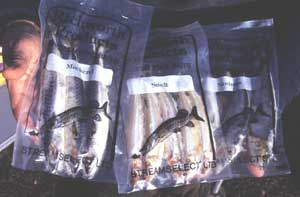Pike hunt by using three senses: sight, sound and smell. The vastmajority of pike anglers everywhere take great advantage of thepike’s sense of sight by using artificial lures and by fishingdeadbaits spun, sink and draw, and wobbled. We rely on the pikeseeing these animated baits and attacking them. We also try to appealto the pike’s sense of hearing by using, for instance, lures thatrattle. When I refer to the sense of hearing I am also including thepike’s ability to pick up vibrations through the sensors along thelateral line.
Deadbaiting is a peculiarity of the English, for other Europeans,and the Americans, Canadians, and Australians all prefer to useanimated baits, which are most often artificial lures. Perhaps it isbecause in many areas of the UK we have restricted bank space and aregenerally unable to wander about casting lures, and do not have manysufficiently large enough waters for a great deal of boat fishing.Anyhow, whatever the reason, we UK pikers have developed pike fishingwith sea deadbaits into a method that has accounted for a great manyvery large pike. But it must be said that what has become very noticeable over theyears of pike fishing with all methods is that sea deadbaiting isusually the slowest form of pike fishing, with not as many runscoming to the baits as would come to livebaits and lure fishing. Evenmore noticeable is the fact that sea deadbaits tend to select thebiggest fish.
Obviously, no one knows for certain why this should be so, but Idon’t think it is difficult to work out. As pike grow bigger theymust find it more difficult to conceal themselves in order to ambushtheir prey. They will also be slower, having lost much of thatincredible burst of speed that took their victims by surprise. Thisbeing so they must then begin to rely less on their visual andvibratory senses and more on their sense of smell. So, much of thetime they seek food by sniffing it out; by detecting the scent thatemanates from dead and dying fish. Deadbaits tend to catch the biggest fish Marine species also give off the strongest smell. Not only that,many are also very oily, and these oils seep into the underwatercurrents and lead big pike to their source. And this is why theoiliest, smelliest fish are the best pike deadbaits, the top fourbeing mackerel, sardine, herring and smelt. Mackerel and sardine arevery oily, herring is very smelly, and smelt has a unique odour thatis reminiscent of cucumber – but only when fresh. That is the mostimportant thing with all deadbaits, especially sea species, they mustbe as fresh as possible. Pike do not like decaying fish.
Legered or laid-on baits are usually best Legering is essentially the best way of fishing a deadbait, forthat is the most likely place a dead fish will be found! On waterswith clean bottoms a plain and simple legered bait takes somebeating. The bait is cast out and left to lie there, giving off itsscent and oils, while you hope the pike pick up the trail that leaksinto the currents and follow it to its source. Many times,particularly with mackerel and herring, I cut the head off the baitto allow more of the blood and oils to escape into the water.
When you do this, though, you must be prepared to change the bait moreoften – every two to three hours, say – for the leakage rate will befaster and therefore the bait will lose its vital scent and oils somuch more quickly. Popped up baits On waters where the bottom is weedy it is best to fish the bait’popped up’ anything from just standing on its tail to several feetoff bottom, depending on the depth of the weed. Popped up deadbaits(up to 6ins or so) can be very attractive to pike anyhow, for theyare easier to detect and easier to take into their mouths. When Ifish two or more rods for pike with deadbaits I always begin with abait that lies on the bottom and one that is popped up. It issurprising how often the popped up bait catches more fish, even onclean bottoms. One of the other advantages of using a popped up baitis that you can slowly twitch the bait along the bottom without thehooks fouling. The twitched bait method can be very good when thepike are in a dour mood and a little movement is needed to attracttheir attention.
Deadbaits can be made to float off bottom by inserting buoyantmaterials such as balsa and polystyrene into their bodies via themouth or gills, or straight into the body cavity if using halfbaits. There is no reason why anyone should not try a sea deadbait thatis suspended under a float, for it is as likely to attract pike asany other inanimate bait, but I do feel that sea species deadbaitsare at their best when lying on, or close to, the bottom. Whichever method you use, try not to cast too often, for this willundo the good work a smelly bait does when it lies in one spot for alengthy period giving off its scent and oils. Be patient and the pikewill usually find the bait. |
Welcome!Log into your account















